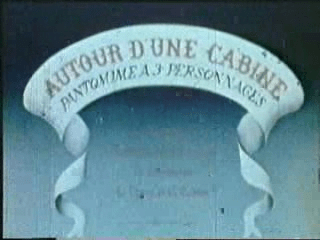Film History Essentials: Autour d’une cabine (1894)
(English: Around a cabin)
Several people enjoy a day at the beach, including some divers, a couple with a small dog, and a rather rude peeping tom. A man in a boat signals the end of the film with his sails.
By the first few months of 1894, Charles-Émile Reynaud and his Théâtre Optique had been presenting the same three animations five times daily for almost a year and a half. In March, the show closed while he worked on new material, and one of the two new animations he produced was Autour d’une cabine ou Mésaventures d’un copurchic aux bains de mer (or, in English: Around a Cabin or Misadventures of a Couple at the Seaside). This new work was composed of 636 individual, hand-painted images, and although it lasts about 2 minutes when played straight through at regular speed, just as with Pauvre Pierrot, Reynaud turned it into a performance, extending the runtime to 10 minutes or more.
During the months he was closed, Edison’s kinetoscope arrived in Paris. These live-action moving images had the benefit of novelty, but the films that were produced for them still lacked the length and sophistication of Reynaud’s work. Plus, the kinetoscope only allowed one viewer at a time, while the Théâtre Optique was projected for a whole audience. It would be another full year before Reynaud’s animations faced competition from actual projected motion pictures, and he didn’t give his final show until February 28, 1900.
Aside from Pauvre Pierrot, Autour d’une cabine is the only other one of Reynaud’s works to survive his destruction of his own work in a bout of depression after the closing of his show. It’s certainly interesting to see an example of his second group of films for the Théâtre Optique, to observe how his technique has developed, and how the medium hasn’t. There are a lot more characters and events in Autour d’une cabine, and the scenery is more elaborate. In particular he’s got to deal with characters entering and leaving the water, which is tricky as the water is part of the static background scenery, but the characters are not.
The various little devices that make up the whole thing are more clever, and the ship that sails out to declare that the show is over is a particularly nice touch. But it’s still essentially the same thing as his earlier work. The fundamental technology behind it hasn’t advanced in any way that allows for innovations that might compete with what’s coming.
Screening:
It’s strange to watch this in the context of the early kinetoscope films. When Pauvre Pierrot was first exhibited, the handful of people who had access to a motion picture at all might have seen a few seconds of someone waving and bowing. Edison and Dickson were barely past the Monkeyshines days of images blurred beyond recognition into a shapeless blob. But by the time of this release, sure the motion pictures were less than a minute long and in black and white, but you could watch actual moving images of world-famous performers like Annie Oakley, or watch a dance from Spain, or the Native American West, or Japan.
Autour d’une cabine hasn’t lost any of the charm of Pauvre Pierrot. If anything, it’s a better and more engaging film, particularly to a modern audience. But somehow, where its predecessor felt vibrant and alive, this feels like the last rally of something that has lost its relevance and just doesn’t know it yet. The ghostly translucence of Reynaud’s characters in the scene has taken on a different tone entirely, like they are haunting a space that is no longer theirs to inhabit.






[…] in one way or another, as “actualities” (including one that is reminiscent of a popular Reynaud animation that was still playing across town). Then there are a few that are filmed performances such as […]
LikeLike
Film History Essentials: Le Débarquement du Congrès de Photographie à Lyon (1895) | Moviegoings said this on February 11, 2023 at 10:00 am |